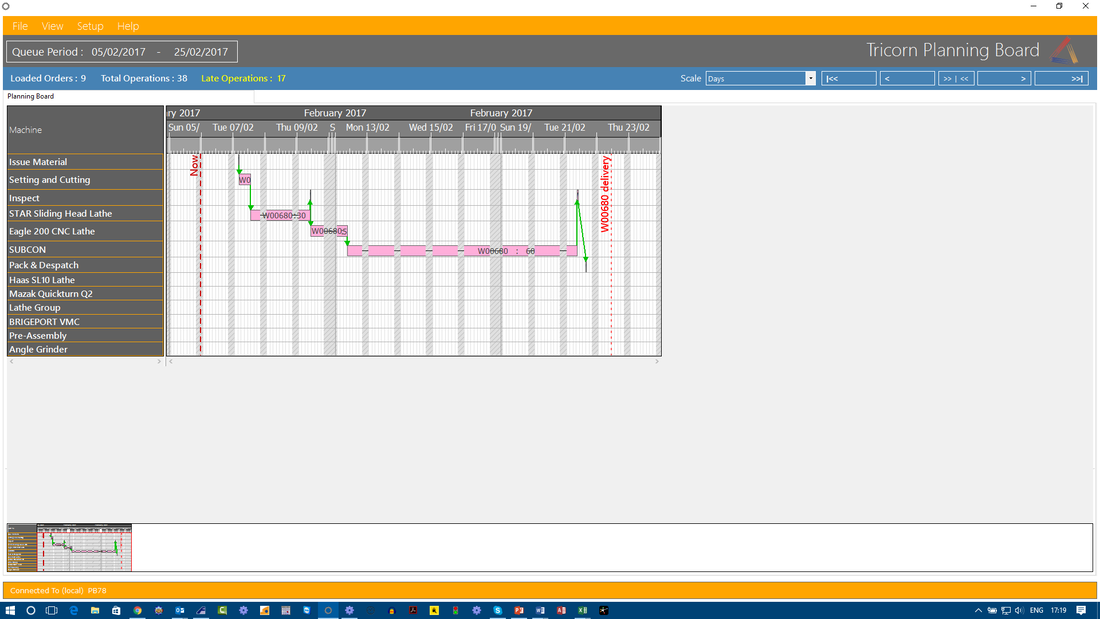Many engineering/manufacturing companies would love to be able to achieve all their delivery dates either on-time or early. But juggling multiple resources and dozens - if not hundreds – of jobs concurrently with machine down-time and changing priorities makes the task virtually impossible. So, what can you do to achieve delivery targets?
Spreadsheets?
Many Production Planners resort to complex spreadsheets to manage jobs as they flow through the workshop. Preparing the machine loading and priorities at the start of the week with the best of intentions - but then within the first few hours, something comes up and all the plans have to change again. An urgent job has arrived; expected raw materials have not been delivered; a machine malfunctions; all these factors can throw a well-structured plan into immediate disarray.
In addition, communication between the shop floor and the Production Planner needs to be timely and accurate. It’s no good developing a plan if the shop floor operators are not recording where they are on each operation – e.g. operation started, operation paused (and why), operation completed (and how many parts finished?). Otherwise, you how will you know if the plan is being kept to? And what are causes of any delays?
In addition, communication between the shop floor and the Production Planner needs to be timely and accurate. It’s no good developing a plan if the shop floor operators are not recording where they are on each operation – e.g. operation started, operation paused (and why), operation completed (and how many parts finished?). Otherwise, you how will you know if the plan is being kept to? And what are causes of any delays?
A Typical Example
To explain what I mean, let's look at a typical routing in an engineering workshop:
Job No: 680: No. of parts: 300
Job No: 680: No. of parts: 300
The workflow for a routing like this could be:
This takes a waterfall approach, where each task needs to be completed before starting the next one. As you can see, this leaves a buffer of just one day before the requested delivery date!
So, what could be done to increase the buffer period? Could the sub-contract heat treatment operation be done in less than seven days? Could we overlap operations? If so, what impact would that have?
Also, this just shows one job! What if another job on the Lathe runs late? If I make changes, what will be the impact on other jobs?
Just a simple routing like this can throw up complex issues that are extremely difficult to resolve. With dozens of work centres and many jobs being processed each month, maintaining control of the schedule becomes a very daunting task using just a spreadsheet – it’s very much “finger in the air” - and unsurprising leads to late deliveries.
So, what could be done to increase the buffer period? Could the sub-contract heat treatment operation be done in less than seven days? Could we overlap operations? If so, what impact would that have?
Also, this just shows one job! What if another job on the Lathe runs late? If I make changes, what will be the impact on other jobs?
Just a simple routing like this can throw up complex issues that are extremely difficult to resolve. With dozens of work centres and many jobs being processed each month, maintaining control of the schedule becomes a very daunting task using just a spreadsheet – it’s very much “finger in the air” - and unsurprising leads to late deliveries.
How can a Scheduler Help?
A Scheduler or Planning system can make the job a lot easier. Even just the visual representation above makes it clearer to see that there is a very small buffer period that could easily be eroded.
Further to this, a planning tool can make it easier to resolve those complex issues through the following methods:
Further to this, a planning tool can make it easier to resolve those complex issues through the following methods:
Grouping Machines
Many engineering companies have multiple machines that can perform the same task. Can you group your similar machines and then later decide which machine it will run on? Could you split a single job over multiple machines and maintain traceability?
Maybe your machine group can process many of the same jobs, but of different sizes. Can your planner automatically allocate parts that will only fit in the biggest machine? or does the planner need to know before assigning the job?
Maybe your machine group can process many of the same jobs, but of different sizes. Can your planner automatically allocate parts that will only fit in the biggest machine? or does the planner need to know before assigning the job?
Real-time Communication
For a scheduling system to work most effectively, it needs to be updated by real-time changes to the shop floor. And this is best controlled by your engineers on the shop-floor.
Getting your team to clock-on and clock-off jobs with some form of barcode or touch-screen data capture solution can alert the scheduler when operations run late can inform the scheduler and can alter schedules according to the change in resource availability.
Recording when an operation is started would immediately move the operation forward and set the status to “WIP”. Recording when an operation is paused and how many parts were completed can indicate to the scheduler how much additional time will be required to complete the operation. If the actual cycle time is different to the estimate, an advanced scheduling system should be able to re-calculate the projected end time – either bringing it forward or moving it out.
Getting your team to clock-on and clock-off jobs with some form of barcode or touch-screen data capture solution can alert the scheduler when operations run late can inform the scheduler and can alter schedules according to the change in resource availability.
Recording when an operation is started would immediately move the operation forward and set the status to “WIP”. Recording when an operation is paused and how many parts were completed can indicate to the scheduler how much additional time will be required to complete the operation. If the actual cycle time is different to the estimate, an advanced scheduling system should be able to re-calculate the projected end time – either bringing it forward or moving it out.
Split Operations
When you have an urgent job, it may well make sense to run it on many machines concurrently if you can do so. An advanced scheduling system should be able to manage this easily and effectively, whilst maintaining traceability of which machine the parts were produced on.
Machine Efficiency
Machine efficiency is critical to your operation. Knowing you're maximising the output to meet deadlines. But how do you currently measure the efficiency of your machines? Do you know how much downtime is spent between jobs? Could you leave machines running while your team are on lunch break? Or is that downtime for the machines?
We’d all love our machines to run consistently at 100% but this virtually never happens. With an advanced scheduler, you should be able to build in a buffer for short down-time periods and clean up to provide a more realistic projection of job/operation end time.
And with the right reporting tools, you're be able to analyse what's really going on and understand how to improve it moving forwards.
We’d all love our machines to run consistently at 100% but this virtually never happens. With an advanced scheduler, you should be able to build in a buffer for short down-time periods and clean up to provide a more realistic projection of job/operation end time.
And with the right reporting tools, you're be able to analyse what's really going on and understand how to improve it moving forwards.
More Accurate Delivery Dates
A scheduler might help you identify that the dates your customers are requesting are simply unrealistic, and it's going to be a real struggle to meet them. However, having a clear, visual schedule of jobs that updates in real-time can give your sales teams a clear picture of capacity availability. This gives them the tools to know when might you be able to do a job, and deliver it, before accepting it and promising a delivery date.
In a really advanced system, your sales team should be able to perform 'what-if' analysis, and see how taking on a job might affect other jobs you have on. Will it make them late? Will it place a greater burden on a specific supplier? What's their availability. All this can help you ensure you will realistically be able to deliver on all jobs you take on before accepting them.
In a really advanced system, your sales team should be able to perform 'what-if' analysis, and see how taking on a job might affect other jobs you have on. Will it make them late? Will it place a greater burden on a specific supplier? What's their availability. All this can help you ensure you will realistically be able to deliver on all jobs you take on before accepting them.
A Scheduler isn't a Magic Pill
All this is not to say that a scheduler will magically solve your problems. You still need to right people and processes in place so that a scheduler compliment and improve your existing setup.
It's important to note the following situations:
It's important to note the following situations:
- No scheduling/planning system will be effective without process adherence.
- If operation setting & cycle times are either not set or set inaccurately, the system won’t work.
- If operators don’t logon/logoff operations and communicate with the scheduler, the system won’t work.
- If delivery/target completion dates are not realistic, the system won’t work.
- If capacity/shift patterns are not set correctly, the system won’t work.
Can a Scheduler Improve Your Delivery Performance
If you're looking to improve your on-time in-full performance and you have the right people and processes in place, then a scheduler could be the perfect piece to help you drive improvements.
At Tricorn, we offer Europe's leading Scheduler that integrates seamlessly with our Tricorn: Production, SFDC and Dashboard products to provide real-time updates, what-if analysis, and automated scheduling that is visible throughout your business.
The Tricorn: Scheduler has helped our customers improve on-time delivery and customer retention, leading to winning new work and new customers.
If you need help to achieve your delivery targets, our team are happy to help. Please contact us.
At Tricorn, we offer Europe's leading Scheduler that integrates seamlessly with our Tricorn: Production, SFDC and Dashboard products to provide real-time updates, what-if analysis, and automated scheduling that is visible throughout your business.
The Tricorn: Scheduler has helped our customers improve on-time delivery and customer retention, leading to winning new work and new customers.
If you need help to achieve your delivery targets, our team are happy to help. Please contact us.





 RSS Feed
RSS Feed
